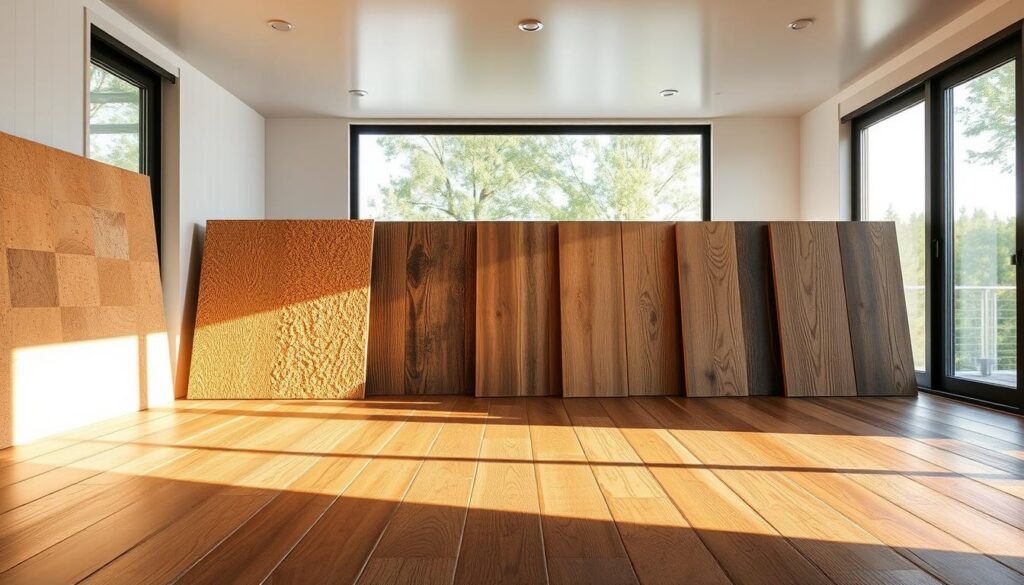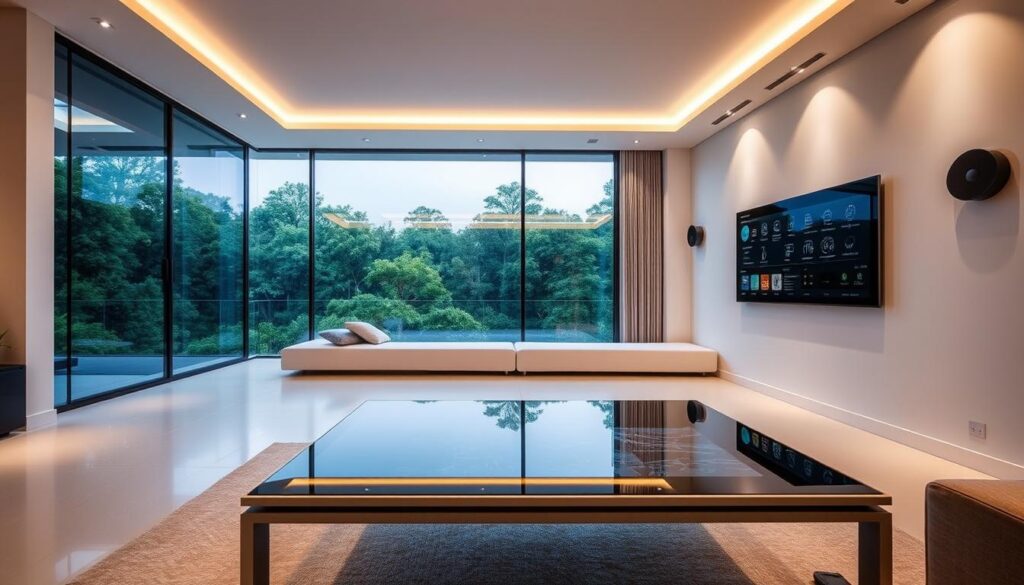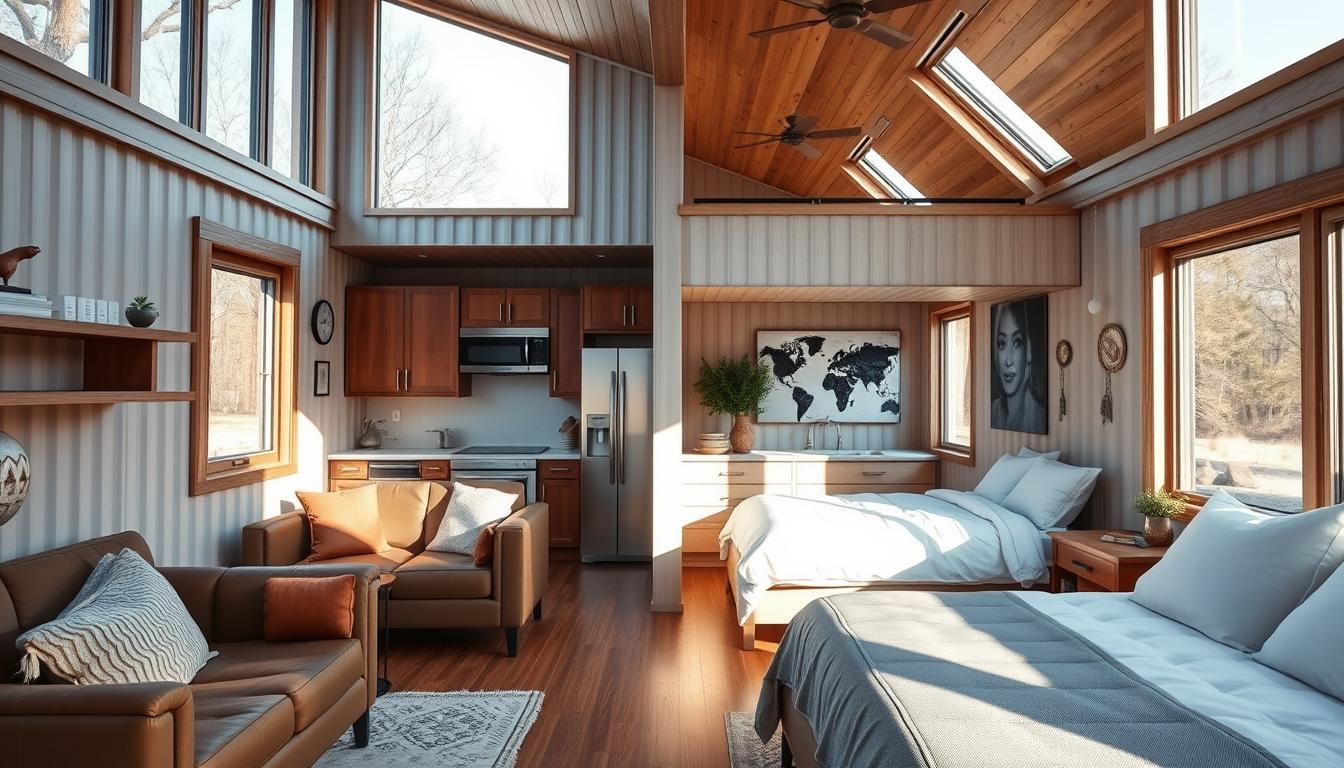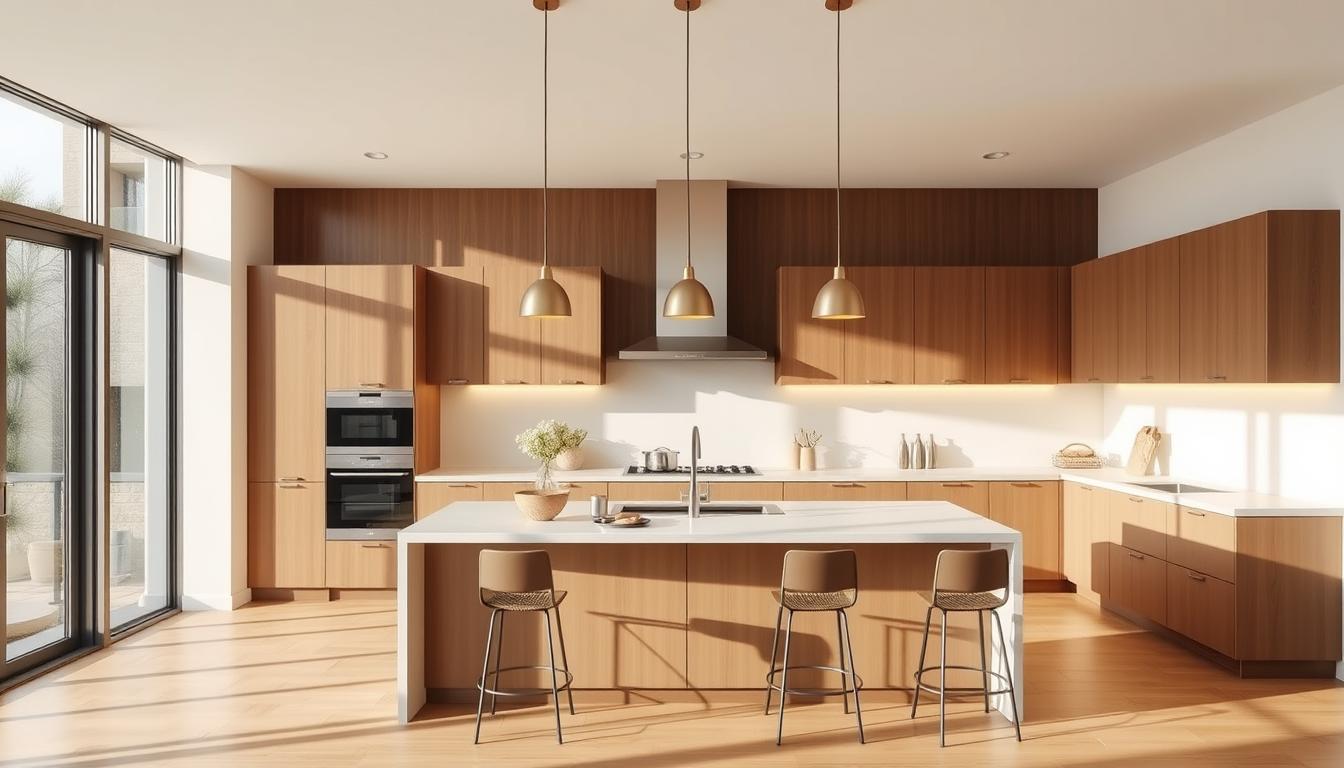Did you know over 20 million shipping containers are used worldwide? Many are turned into unique homes. This trend has led to a big demand for design ideas that make these steel structures cozy and modern.
At our company, we focus on creating stunning interiors for these homes. We know the special challenges and chances of shipping container homes. We’re excited to share our knowledge with you. We mix modern aesthetics with practical design to make interiors that are both beautiful and functional.
Key Takeaways
- Transforming shipping containers into homes requires innovative design solutions.
- Modern aesthetics play a crucial role in creating livable spaces.
- Our team specializes in crafting unique interiors for shipping container homes.
- Functional design is key to making these spaces comfortable.
- Repurposing shipping containers is a growing trend in home design.
Understanding the Benefits of Shipping Container Homes
Shipping container homes are becoming popular for good reasons. They offer many benefits that make them a great choice for sustainable living. Let’s look at why they’re gaining popularity.
Sustainability and Eco-Friendliness
Shipping container homes are good for the planet. They help reduce waste by using old containers instead of new materials. This not only cuts down on environmental harm but also supports the use of eco-friendly materials.
Using old containers for homes also promotes a culture of sustainability. It encourages people to think about reducing waste and protecting the environment.
Cost-Effectiveness
Shipping container homes are also a smart financial choice. They cost less to build than traditional houses. This is because containers are sturdy and need less foundation work, saving money.
They also save money over time. The recycled materials and strong construction mean less maintenance is needed.
Versatile Design Options
Shipping container homes are very flexible. They can be changed and combined to fit different needs. This means you can create a home that’s just right for you.
Plus, you can make them look any way you want. From modern to rustic, the possibilities are endless. This lets you express your personal style.
Key Elements of Shipping Container Interiors
Designing the inside of a shipping container home is complex. It involves making the most of space, adding natural light, and setting up functional areas. Learning about these elements will help you optimize your container home’s interior.
Space Optimization
Space is key in shipping container homes because they are small. Using space wisely means finding smart storage and furniture that does more than one thing. For example, wall shelves and hidden spots can make a big difference.
“Think vertically and use every corner,” advises an interior design expert.
“This way, you can make your home feel big and cozy, even in a small container.”
Natural Light Integration
Adding natural light can change a shipping container home’s feel. Placing windows, skylights, or light tubes lets in plenty of light. Getting more natural light cuts down on the need for artificial light and makes your home look better.
- Install big windows or sliding glass doors
- Use skylights or solar tubes for overhead light
- Add reflective surfaces to spread light around
Functional Layouts
A good layout is crucial for a shipping container home’s function. Open floor plans make rooms feel bigger. But, having separate areas for different activities keeps things organized.
Think about how you move around your home. Put important areas like the kitchen and dining in the middle. Bedrooms can be in quieter spots.
Aesthetic Appeal
The look of a shipping container home shows off your style. You can go for modern or rustic, whatever you like. Picking the right colors, materials, and decor can make your home cozy and welcoming.
Using natural materials like wood and stone adds warmth. Metallic touches can highlight the industrial vibe. The goal is to mix function with your personal style for a unique and lovely home.
Choosing the Right Design Style for Your Container Home
Choosing the right design style for your container home is key. It should reflect your personality and meet your needs. Your design style affects your home’s look, function, and comfort.
Modern Minimalism
Modern minimalism is all about simplicity and clean lines. It’s great for those who love open and clear spaces. To get this look in your container home, try these tips:
- Stick to a neutral color scheme for calm and serenity.
- Choose furniture that does more than one thing.
- Use lots of natural light with big windows and skylights.
Rustic Charm
Rustic charm offers a cozy, traditional vibe. It uses warm tones and nostalgic decor. To bring this style to your container home, consider:
- Use reclaimed wood for floors, walls, or furniture.
- Add vintage or antique pieces for charm.
- Include natural elements like stone or brick.
Industrial Edge
Industrial edge celebrates the container’s raw look. It keeps metal walls and ceilings exposed. To achieve this look, try:
- Keep some original features like metal walls or ceilings.
- Choose industrial-style lighting and decor.
- Use materials like concrete, steel, and glass.
Looking for more ideas? Check out our tips on revamping your trailer home interior.
Essential Materials for Container Home Interiors
Choosing the right materials for a shipping container home’s interior is key. We aim for both sustainability and beauty. The goal is to pick materials that are good for the planet and make the space cozy.
Flooring Options
Finding the perfect flooring is essential for a welcoming feel in a container home. Eco-friendly choices include:
- Bamboo flooring: It’s durable and comes from a fast-growing plant.
- Reclaimed wood: It brings a rustic vibe and cuts down on waste.
- Cork flooring: It’s soft and keeps moisture at bay.
These options are eco-friendly and add a special touch to your home’s interior.

Wall Treatments
The right wall treatments can change the feel of a container home. Consider:
- Low-VOC paints: They help keep the air clean and healthy.
- Reclaimed wood paneling: It adds texture and warmth.
- Natural stone: It’s durable and looks great.
These choices are not just pretty. They also make your home a healthier place to be.
Furniture Selection
Choosing furniture is important for both space and comfort in container homes. Opt for:
- Multi-functional furniture: Items that do more than one thing, like storage ottomans.
- Sustainable materials: Pieces made from recycled or eco-friendly sources.
- Compact designs: Furniture that fits well in the home’s space.
By picking the right furniture, we can make a cozy and useful living area. This fits with the eco-friendly spirit of container homes.
Maximizing Space in Small Shipping Container Homes
Small shipping container homes can be stylish and functional. The right design strategies can make them feel spacious and inviting. We specialize in turning compact spaces into cozy living areas.
It’s key to focus on design elements that enhance space perception and use. These elements make a big difference.
Multi-Functional Furniture
Incorporating multi-functional furniture is a smart way to save space. Items like storage ottomans, sofa beds, and drop-leaf tables serve more than one purpose. They reduce clutter and boost functionality.
For instance, a storage ottoman can be a place to sit and store items. A sofa bed can be a day seating area and a cozy bed at night.
Vertical Storage Solutions
Using vertical storage is another key strategy. It keeps floors and surfaces clear, making the space feel open.
- Install shelves or storage units that go up to the ceiling.
- Use wall-mounted cabinets and hooks to hang items.
- Choose tall, narrow bookshelves or storage units.
These solutions keep belongings organized and draw the eye upwards. This makes the space feel larger.
Open Floor Plans
Open floor plans are great for making small spaces feel bigger. Fewer walls and partitions create a sense of continuity and flow.
This design lets natural light move freely. It enhances the feeling of spaciousness.
| Design Element | Traditional Approach | Space-Saving Approach |
|---|---|---|
| Furniture | Single-function pieces | Multi-functional furniture |
| Storage | Horizontal storage solutions | Vertical storage solutions |
| Floor Plan | Segmented floor plan | Open floor plan |
By using these space-saving strategies, you can enjoy a comfortable and functional living space. Even in the smallest shipping container homes.
Incorporating Technology and Smart Features
As we keep pushing the limits of shipping container homes, adding tech and smart features is key. It makes living better and helps with sustainable living and cost-effective solutions.
Smart home tech lets homeowners control their space from afar. They can change lights, temperature, and entertainment with just a tap on their phone or a voice command.
Smart Home Integration
Smart home integration connects devices and systems to a central hub. This makes controlling lights, heat, cool, and security easy. It helps save energy and makes homes more comfortable.
For example, smart thermostats learn your schedule to save energy. Smart lights change color and brightness based on the time or if you’re home. This all helps save energy.

Energy Efficiency Solutions
Energy efficiency is vital for sustainable living in shipping container homes. Smart tech helps cut down energy use. This includes using efficient appliances and smart power strips.
Adding solar panels also helps. It makes homes less dependent on the grid. This makes homes more eco-friendly and self-sufficient.
Security Enhancements
Security is a big deal for any homeowner, including those in shipping container homes. Smart security like CCTV cameras, motion sensors, and smart locks boost safety and peace of mind.
These systems can be watched from anywhere. Smart door locks let you control who gets in and for how long. This adds to both convenience and security.
With these tech additions, shipping container homes become more than just places to live. They become comfortable, convenient, secure, and sustainable.
Personalizing Your Shipping Container Home Interior
Your shipping container home is a blank canvas. It’s waiting for your personal touch. Making it warm and inviting is all about reflecting your style and needs.
Choosing a Color Palette
Choosing the right colors is key. Colors set the mood of your home. For a modern look, use neutral colors like white, gray, and black. Add bold colors to make it interesting.
Here’s a look at different color palettes and their effects:
| Color Palette | Ambiance | Ideal For |
|---|---|---|
| Monochromatic Neutrals | Calm, Serene | Minimalist Designs |
| Bold and Bright | Energetic, Vibrant | Modern, Contemporary Spaces |
| Earth Tones | Warm, Inviting | Rustic or Natural Themes |
Personal Decor and Artwork
Personal decor and artwork make your home unique. Choose pieces that speak to you. They could be family photos, travel souvenirs, or handmade items. They add interest and tell your story.
Think about the size of your space when picking decor. In small homes, big pieces can make a bigger impact. Mixing textures adds depth and warmth.
Indoor Plants and Greenery
Adding indoor plants is a great way to personalize your space. Plants clean the air and bring nature inside. This is perfect for metal homes.
Choose plants based on light and care needs. Succulents and air plants are easy to care for. If your home gets lots of light, you can have lots of greenery.
By picking the right colors, adding personal touches, and using plants, you can make your shipping container home beautiful. It will truly reflect your personality and style.
The Role of Lighting in Container Home Design
Lighting is key in making a shipping container home feel cozy and inviting. It’s not just about lighting up the space. It’s about creating a warm atmosphere that turns the metal container into a home.
When designing lighting for a container home, think about both natural and artificial light. Natural light makes the space feel bigger and more welcoming. Big windows and skylights help bring in natural light. But, since container homes are made of metal, they can get very hot or noisy, making artificial light necessary.
Natural vs. Artificial Lighting
The mix of natural and artificial lighting is important in container home design. During the day, natural light can be maximized with smart window placement and reflective surfaces. As night falls, a good artificial lighting system keeps the space bright and cozy.
Artificial lighting can be adjusted for different needs and moods. You can have bright lights for tasks or soft lights for relaxing. Layered lighting, using different light sources, creates a welcoming atmosphere.
Statement Light Fixtures
Statement light fixtures add personality to a container home’s interior. They provide light and act as decorative pieces, enhancing the space’s look. From industrial pendants to elegant chandeliers, the right fixture can be a room’s centerpiece.
When picking statement light fixtures, match them to your home’s style and materials. For example, a simple pendant light works well in a minimalist home, while a rustic design might look great with a vintage fixture.
Layered Lighting Techniques
Layered lighting uses multiple sources to create a complex lighting scheme. This method adds flexibility and enhances a container home’s function and feel. By mixing different lights, you can control brightness and add visual interest.
To use layered lighting, first identify the lighting needs of your home’s areas. The kitchen might need bright lights, while the living area should have softer lights. By combining overhead, table, and floor lamps, you can achieve a layered effect that makes your space feel lively and inviting.
Good lighting design is essential for a comfortable and stylish container home. By balancing natural and artificial light, adding statement fixtures, and using layered lighting, you can create a warm and welcoming space that’s truly yours.
Ensuring Comfort and Functionality
When turning shipping containers into homes, comfort and function are key. To make a living space warm and inviting, we must focus on several important areas. These include heating and cooling, soundproofing, and creating cozy spots.
Heating and Cooling Solutions
Keeping a comfortable temperature is crucial in any home. For shipping container homes, we look for cost-effective solutions that support sustainable living. Some good options are:
- Installing energy-efficient HVAC systems for small spaces.
- Using radiant floor heating for steady warmth.
- Applying passive solar design to enhance natural heating and cooling.
These methods help cut down energy use and support an eco-friendly lifestyle.
Soundproofing Techniques
A quiet home is key for comfort. For shipping container homes, we recommend several cost-effective soundproofing methods:
- Adding mass to walls and ceilings with acoustic insulation.
- Sealing gaps and joints with acoustic sealants.
- Using sound-absorbing materials in interior design.
These strategies help reduce outside noise and make your home quieter and more peaceful.
Creating Cozy Spaces
Cozy spaces are essential for a welcoming shipping container home. We choose eco-friendly materials and design spaces that encourage relaxation and socializing. Some ideas are:
- Using reclaimed wood for furniture and decor.
- Adding plush textiles and comfy seating areas.
- Designing spaces that serve many purposes, from work to play.
By combining these elements, we create a warm and inviting atmosphere that improves your living experience.
Outdoor Living Spaces
Outdoor living spaces are key in shipping container homes. They make the transition from inside to outside smooth. This way, homeowners can make their living area bigger and better.
Expanding Interior into the Outdoors
Shipping container homes are great at mixing indoor and outdoor living. We do this by adding big sliding glass doors or removing parts of the wall. This makes the living area feel bigger and brighter.
To make the inside feel like the outside, consider adding:
- Outdoor kitchens with modern appliances and cooking facilities
- Comfortable seating areas with weather-resistant furniture
- Fire pits or outdoor fireplaces for cozy gatherings
Creating Functional Patios
A good patio can make a shipping container home even better. We use strong, weather-proof materials for floors and furniture. Some top picks are:
- Composite decking for easy care and lasting quality
- Natural stone or brick pavers for a rustic feel
- Recycled plastic furniture for eco-friendly and tough seating
When making a patio, think about how you’ll use it. We suggest having different areas for sitting, eating, and maybe even cooking outside.
Outdoor Furniture and Decor
Picking the right outdoor furniture and decor is key. We look for pieces that are stylish, strong, and can handle the weather. Some modern looks to try are:
- Sleek, minimalist furniture with clean lines and simple shapes
- Bold, statement pieces like colorful outdoor rugs or decorative planters
- String lights or lanterns to add ambiance and warmth
By using these ideas, homeowners can make outdoor spaces that are both pretty and useful. This makes their shipping container home even more appealing.
Frequently Asked Questions about Container Home Interiors
Exploring shipping container homes raises many questions about their interior design. We tackle common worries and myths to guide you in choosing the right interior for your container home.
Addressing Common Concerns
Cost is a big worry for many when it comes to designing a shipping container home’s interior. But, there are affordable ways to make your space look amazing. Our ideas help you use every inch of space and add features that do more than one thing.
Budgeting for Your Container Home
When planning your budget for a shipping container home’s interior, think about the materials and finishes you pick. Choosing affordable options and focusing on what you need most can help you stay within budget. This way, you can still have a beautiful and useful space.
DIY vs. Professional Design Services
DIY projects are tempting, but for complex container home interiors, we suggest getting professional help. Design experts can guide you through the process. They ensure your design is both efficient and meets your needs, adding a unique touch to your home’s interior.



